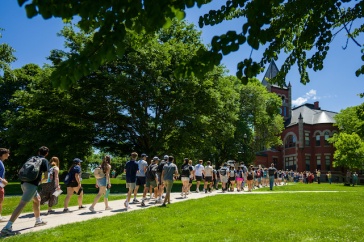
Clockwise from back left: Caroline Leyva, Katie Edwards, Vicki Banyard, Mary Mayhew, Sharon Murphy, Sharyn Potter, Jane Stapleton, Mary Moynihan and Robert Eckstein.
Nine faculty and staff members are gathered around a conference table in Huddleston Hall. Each has carved out a space amidst the papers, bagels, laptops, bananas, and coffee for a four-hour retreat. Today’s goal? To plan the future of their research center, Prevention Innovations. The tenor of the room is hopeful, excited. The future is filled with possibility. That’s partly because the past has been such an unmitigated success for this collection of scholars.
Established at UNH in the fall of 2006, Prevention Innovations has, in its relatively short life, established its faculty as national leaders in research and practices for ending violence against women. Though the center has a half-dozen projects going at any one time, one of its most widely known is a bystander intervention program developed for college campuses. Bringing in the Bystander® is an in-person training program that teaches bystanders how to intervene safely before, during, or after an incident of sexual and relationship violence or stalking. The idea is to foster a sense of individual responsibility within a community. The Know Your Power® Bystander Social Marketing Campaign uses posters, bus wraps, bookmarks, and other marketing materials in a media blitz that focuses on the same message.
Both Bringing in the Bystander and Know Your Power have run successfully at UNH a number of times, and they’ve spread to campuses across the country. The programs have even been implemented at two U.S. army posts in Europe. Prevention Innovations just finished a one million dollar grant from the Centers for Disease Control and Prevention, part of which supported the programs at UMass Lowell. A recent University of California system/Verizon grant supported the adaptation of Know Your Power at the University of California at Merced, and an Avon grant supported the adaptation at Boise State University.

So successful are the programs that, two years ago, Vice President Joe Biden chose UNH as the place to announce new guidance for Title IX, part of which encourages universities to undertake sexual violence prevention education. Biden’s visit also recognized the work of UNH’s Sexual Harassment and Rape Prevention Program (SHARPP) and other campus prevention efforts, but there is no doubt that it is Prevention Innovations that has caught Washington’s attention. A year earlier, the White House had invited top administrators from the Department of Justice to UNH for a briefing on their research.
Though other prevention programs are available nationally, none has included the level of assessment integral to the UNH programs. Pre- and post-tests are administered to participants, with 6- and 12-month follow ups. Measured are changes in attitudes and beliefs about sexual and relationship violence, knowledge of the problem, comfort levels with intervention, and whether or not participants have taken action as bystanders. The programs have yielded positive results in all areas, and the group has evidence to support the claim.
The assessment instruments are based on well-established testing measures, such as the Illinois Rape Myth Scale. Other measures have been developed by the group’s members themselves.
“Vicki Banyard and Mary Moynihan are the ‘gurus’ of measurement,” says Prevention Innovations Co-Director Sharyn Potter. “As Bringing in the Bystander became more well-known, people started requesting the measures Vicki and Mary created for use in their own programs. Now the measures are really ‘it’ in the field—they are very highly respected.”
One goal of the assessments is to make the training programs themselves better. Prevention Innovations goes to the target audience during the development and evaluation of prevention strategies. They work closely with practitioners to implement their programs, part of which includes adapting them to ensure that they fit communities’ needs. It’s a unique approach. Few sexual violence prevention programs in the U.S. tailor their programs on an individual basis.
Potter and Co-Director Jane Stapleton visited the campus at the University of California, Merced, before implementing the Know Your Power campaign. They conducted focus groups with over 200 students to learn what scenarios resonated with Merced students. They found that existing social marketing images of overwhelmingly white students in a northeastern landscape had little relevance to the largely Hispanic student population in sunny California. The messages of the campaign were lost on students distracted by the medium itself.
“We showed the Merced students a photo we had taken at UNH’s Holloway Commons, with the windows and brick buildings in the background,” says Stapleton, “and they said, ‘when we look out our windows, we don’t see brick buildings.’ The message that the students were giving us was ‘that’s not here, that’s not me.’”
So Potter and Stapleton worked with a photographer and students at Merced to create images that would speak to the students’ experience. They’ve coined a term for why this approach is important: Social Self Identification. Unless students see themselves in the contexts and actors depicted in the prevention programs, the messages will not resonate and the programs will be less effective.
It is this focus on research, assessment, and tailored implementation that positions Prevention Innovations well to continue to make an impact in their field. Back in the conference room, the group has hammered out a blueprint for the future. Not all of their plans are ready for prime-time, and the list of those that are is long. Here’s a sample of upcoming projects.
Group members will collect pilot data at three historically black colleges and universities to assess how to adapt Know Your Power for these campuses. Very few prevention strategies address minority populations, notes Potter. Few—if any—strategies address the lesbian, gay, bisexual, and transgender communities. The group will focus attention on prevention strategies in these communities where, research suggests, unique factors are at play, such as threats of outing to silence victims. Group members have teamed up with a social justice game designer from Dartmouth to write a grant to develop a bystander intervention videogame. If successful, they’ll pilot the game on the UNH campus before distributing it more widely. While much of the group’s work is centered on college campuses, they will continue to expand their work beyond campus communities to include high school, professional, and U.S. military environments. Members will continue to develop creative ways to train students, professionals, and practitioners about their unique approaches to research, prevention, and collaboration. A recent “Evaluation Institute” by Prevention Innovations provided professionals with the skills and practice to evaluate their own prevention programs.
The broad goals of this research center are to more widely collaborate with scholars and practitioners in the field. They’ve recognized that they have something unique to offer: not out-of-the-box programs developed by companies dependent on product sales, but individualized programs and consultations based on research and developed within the framework of a major research university by a team highly invested in prevention strategies that work.
The need for prevention programs is not waning, say Potter and Stapleton. The rates of many violent crimes—murder, child victimization, for example—have decreased over the past 30 years, but, sadly, rates of sexual assaults on campuses have remained steady since 1987 when the first large study of the problem was released.
“The 18-24-year-old age group is at the highest risk for being both victims and offenders,” says Stapleton. “There’s something very unique about the college campus experience.”
Success for this research group will be a substantial and continuing reduction in sexual and relationship violence and stalking on campuses and in communities across the world. Until that happens, Prevention Innovations will continue its research and remain loyal to the principles of innovation and collaboration.
To learn more visit Prevention Innovations.
Originally published by:
The College Letter, Newsletter for the College of Liberal Arts
Photography by Julie Byrd-Jenkins for UNH Photographic Services



















































